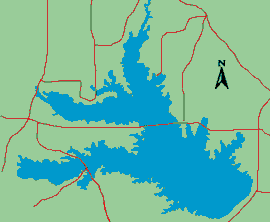Fishing
- Licenses & Regulations
- ShareLunkers
- Fish Identification
- Fish Consumption
- Texas Freshwater Fisheries Center
Water Resources
- Texas Reservoir Levels
- US Army Corps of Engineers
- Texas Water Issues
- Golden Alga
- Aquatic Vegetation
2122 Old Henderson Hwy.
Tyler, Texas 75702
(903) 593-5077
Jake Norman, Biologist
Nearby State Parks
- Lake Tawakoni
10822 FM 2475
Wills Point, TX 75169
903/560-7123 - Purtis Creek
Lake Tawakoni
Quick Links: Fishing Regulations | Angling Opportunities | Cover & Structure | Tips & Tactics
Lake Characteristics
Location: In Van Zandt, Rains, and Hunt
counties, 15 miles southeast of Greenville on Caddo Creek and
the South Fork and Cowleech Fork of the Sabine River
Surface area: 37,879 acres
Maximum depth: 70 feet
Impounded: 1960
Water Conditions
Current Lake Level
Conservation Pool Elevation: 437.5 ft. msl
Fluctuation: Considerable, 3-9 feet
Normal Clarity: Moderately stained
Reservoir Controlling Authority
Sabine River
Authority of Texas
Iron Bridge Division
Box 310
Point, Texas 75472
(903) 598-2216
Aquatic Vegetation
When the reservoir is close to conservation pool, stands of waterwillow, smartweed, and flooded terrestrial species can provide abundant cover. American lotus is significant in some areas. Submerged species such as coontail and hydrilla are generally scarce. When water levels fluctuate or remain low, vegetation tends to be scarce and of little use to fish because much of it is exposed.
Predominant Fish Species
- Striped & hybrid striped bass
- White bass
- Catfish
- Crappie
- Largemouth bass
Lake Records
Current
Fishing Report
Stocking History
Latest Survey Report
Lake Maps
Good topographic maps are available from local businesses and online sources.
Fishing Regulations
Special catfish limits are in effect on this lake.
Angling Opportunities
Striped bass, hybrid striped bass and white bass are vital to the local economy, providing excellent fisheries especially in the lake's open water areas. Striped and hybrid bass are stocked annually by TPWD to maintain the fisheries. Channel and blue catfish are abundant, along with limited numbers of flathead catfish. Largemouth bass is also a popular sportfish in this reservoir. Crappie fishing can be good around standing timber, bridge pilings, and artificial fish attractors.
| Species | Poor | Fair | Good | Excellent |
|---|---|---|---|---|
| Largemouth Bass | ||||
| Catfish | ||||
| Crappie | ||||
| White Bass | ||||
| Hybrid & Striped Bass |
Fishing Cover/Structure
Flooded timber, although not abundant, is found in scattered areas throughout Lake Tawakoni. Aquatic vegetation is sparse and tends to decrease following lake draw-downs. As water levels increase, emergent aquatic plants such as smartweed establish dense areas of cover. Main lake humps tend to attract schools of striped bass, hybrid striped bass, and white bass. The habitat on Lake Tawakoni is limited, so any available cover tends to attract and hold largemouth bass.
Tips & Tactics
Catfishing is one of Lake Tawakoni's sure bets. Anglers use a range of baits including cut bait, shrimp, liver, stink baits and earthworms. Techniques include drift fishing, bank fishing, and trotlining. Catches of trophy blue catfish, especially during winter months are fairly common. Largemouth bass anglers should concentrate their efforts around available cover such as piers, boat houses, vegetation and trees along the shoreline. Peak times for fishing include spring for spawning fish and fall for schooling fish. Spawning fish are frequently caught using spinnerbaits, plastic worms, and jigs. Schooling fish can be caught using crankbaits, spinnerbaits and topwater lures.
In spring and summer, surfacing schools of striped bass, hybrid stripers and white bass can be caught using slabs, spoons, shad-bodied grubs, and topwater baits. Seagulls are attracted when schooling fish chase bait fish to the surface. Early morning, dusk, and overcast days are good times to find these schooling fish. When there is no surface activity, anglers should try vertical jigging slabs or spoons off the bottom or trolling major points using lipless crankbaits, sassy shads and roadrunners. In addition, live shad are used by many anglers to catch hybrids and stripers. Crappie fishing is often concentrated near bridge pilings, submerged trees and brush piles in late spring and fall.
